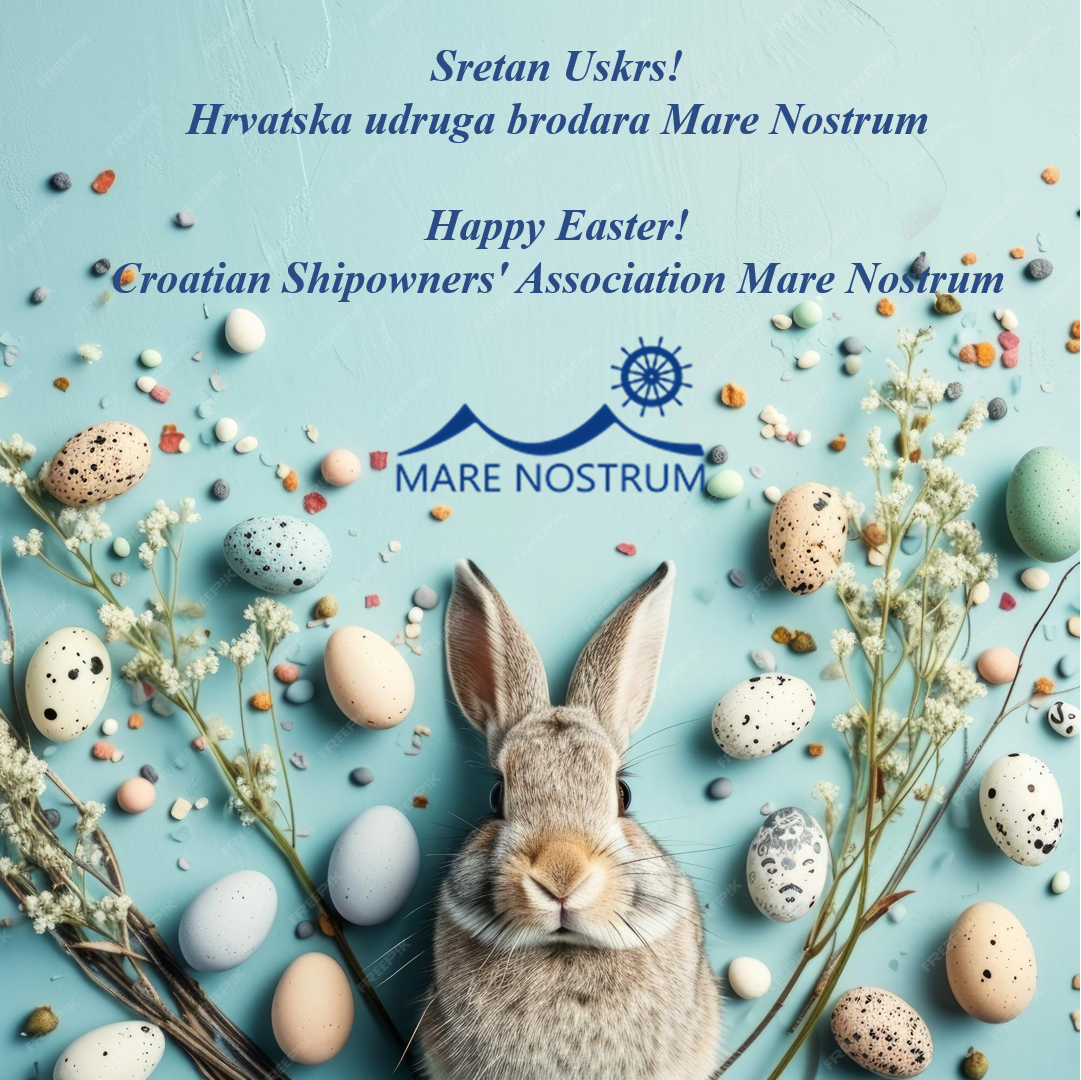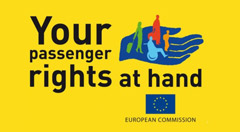Events
12.04.2024
75th anniversary of the Maritime Faculty in Rijeka
We congratulate the Faculty of Maritime Studies, University of Rijeka for 75 years of activity, which has rightly placed it at the very top of the higher education institutions that educate personnel in the maritime field in the Republic of Croatia.
As potential future employers of students of this Faculty, members of Mare Nostrum closely monitor the progress and development of all study programs at the Faculty.
Seafarers are our driving force, so we thank the Maritime Faculty in Rijeka for 75 years of continuous education and training of new maritime personnel who form the core and an indispensable prerequisite for the future development of a strong and competitive shipping industry in the Republic of Croatia.
(1).jpg)
29.03.2024
Happy Easter!

19.03.2024
DG CLIMA and EMSA organized a webinar on the topic of EU ETS
On March 18, 2024, the director of the Croatian Shipowners' Association Mare Nostrum, together with other representatives of our Association, participated in a webinar organized by the Directorate General of the European Commission for Climate Policy (DG CLIMA) and the European Maritime Safety Agency (EMSA).
The webinar presented in detail all the prerequisites for achieving compliance with the obligations from the EU ETS system, and above all, the practical steps related to opening the so-called holding account (Maritime Operator Holding Account) in the Registry of the Union, the opening of which is a prerequisite for fulfilling obligations from the EU ETS system in order to deposit emission units on it. The members of Mare Nostrum, which are EU ETS bonds, submitted all the necessary documentation to the relevant authorities on time and within the open deadline.
08.03.2024
Meeting of the Board of Directors of the European Community Shipowners' Association
On March 5 and 6, 2024, a meeting of the Board of Directors of the European Community Shipowners' Association (ECSA) was held, attended by Mrs. Ivona Anić Miklec, director of HUB Mare Nostrum and Mr. Marko Domijan, president of the HUB Mare Nostrum Assembly.
Together with colleagues from 21 national associations of shipowners from EU member states and Norway, they discussed all current topics in the field of shipping as well as proposals for new EU legislative acts that are currently being discussed under the auspices of the EU Council and the European Parliament.
In the spirit of the upcoming elections at the EU level, the preparation of the European Commission's program for its new five-year mandate was imposed as a logical topic. In this sense, the representatives of Mare Nostrum emphasized that it is crucial that the European Commission works in the new period to maintain and further strengthen the competitiveness of European shipping companies in relation to competitors from third countries, especially bearing in mind the new administrative, technical and financial obligations that imposed on the sector in order to achieve the Union's ambitious goals in the area of reducing greenhouse gas emissions with the aim of making Europe the first climate-neutral continent in the world by 2050. Mare Nostrum advocates that a part of the money collected through the trading of emission units within the EU ETS system, be returned directly to the shipping sector and directed to the financing of the greening of the fleet. We believe that European shipowners will overcome all the challenges ahead of them in unity and synergy.
01.03.2024
22nd Meeting of the Supervisory Board of the Croatian Shipowners' Association Mare Nostrum
Under the newly elected leadership of the Supervisory Board - Mr. Nikola Koščica from Tankerska plovidba d.d. and with the members of the Supervisory Board, Mr. Robert Banko from Alpha Adriatic d.d. and Mr. Vicenco Jerković from Atlantska plovidba d.d. as well as with the presence of Mr. Roman Balta, a long-time associate of the Accounting Association Biro Balta d.o.o. and the leadership of the Association, on February 29, 2024, the 22nd session of the Supervisory Board of HUB Mare Nostrum was held in the Association's premises.
The session was dedicated to the verification of the Association's financial and material operations during the past year, which was assessed as orderly, so the discussion continued in the direction of the upcoming obligations of the Association and the financial and material operations planned in 2024.
| 1 do 5 od 125 događanja | Sljedeća | Zadnja |
News and events
75th anniversary of the Maritime Faculty in Rijeka
We congratulate the Faculty of Maritime Studies, University of Rijeka for 75 years of activity, which has rightly placed it at the very top of the higher education institutions that educate personnel in the maritime field in the Republic of Croatia.
As potential future employers of students of this Faculty, members of Mare Nostrum closely monitor the progress and development of all study programs at the Faculty.
DG CLIMA and EMSA organized a webinar on the topic of EU ETS
On March 18, 2024, the director of the Croatian Shipowners' Association Mare Nostrum, together with other representatives of our Association, participated in a webinar organized by the Directorate General of the European Commission for Climate Policy (DG CLIMA) and the European Maritime Safety Agency (EMSA).
Meeting of the Board of Directors of the European Community Shipowners' Association
On March 5 and 6, 2024, a meeting of the Board of Directors of the European Community Shipowners' Association (ECSA) was held, attended by Mrs. Ivona Anić Miklec, director of HUB Mare Nostrum and Mr. Marko Domijan, president of the HUB Mare Nostrum Assembly.
Together with colleagues from 21 national associations of shipowners from EU member states and Norway, they discussed all current topics in the field of shipping as well as proposals for new EU legislative acts that are currently being discussed under the auspices of the EU Council and the European Parliament.
22nd Meeting of the Supervisory Board of the Croatian Shipowners' Association Mare Nostrum
Under the newly elected leadership of the Supervisory Board - Mr. Nikola Koščica from Tankerska plovidba d.d. and with the members of the Supervisory Board, Mr. Robert Banko from Alpha Adriatic d.d. and Mr. Vicenco Jerković from Atlantska plovidba d.d. as well as with the presence of Mr. Roman Balta, a long-time associate of the Accounting Association Biro Balta d.o.o. and the leadership of the Association, on February 29, 2024, the 22nd session of the Supervisory Board of HUB Mare Nostrum was held in the Association's premises.
124th Session of the Assembly of the Croatian Shipowners' Association Mare Nostrum
The goal of the session was, after reviewing the work of the Association in the previous period, to adopt the Work Plan and Financial Plan for the work of the Association in 2024, as well as to discuss all current topics related to shipping and the work of the Association in general.
Workshop of the Ministry of Economy and Sustainable Development for Shipping Companies
On February 8, 2024, representatives of the members of our Association as well as the Director of the Association, Mrs. Ivona Anić Miklec, participated in another in a series of useful workshops organized by the Ministry of Economy and Sustainable Development on the topic of introducing maritime transport into the greenhouse gas emissions trading system within the Union (EU ETS) as well as the obligations of monitoring and reporting on emissions from maritime traffic that are forthcoming based on Regulation (EU) 2023/957.
Appointment of Ivona Anić Miklec as the director of the Croatian Shipowners' Association Mare Nostrum
On January 1, 2024, Mrs. Ivona Anić Miklec took over the position of director of the Croatian Association of Shipowners Mare Nostrum. Under the leadership of the director, the association will continue to be a responsible social partner in collective negotiations with unions and will promote the interests of Croatian shipowners before all competent bodies of state administration and local and regional self-government, as well as before competent bodies at the international and EU level. In the coming period, the association will strongly support its members in the digital and green transition of their business on the way to sustainable shipping. The association will work on strengthening its identity and cooperation with related associations, as well as strengthening the position of Mare Nostrum under cover of its European family - the European Community Shipowners' Association (ECSA).
EU Emissions Trading System (ETS) seminar
The Croatian Shipowners' Association Mare Nostrum organized an educational seminar on the subject of EU ETS on December 19, 2023, where the keynote address was given by Mr. Dino Kučić, specialist in fuel procurement and sustainable development - EMS/EnMS manager at Croatia Airlines.
123rd session of the Assembly of the Croatian Shipowners' Association Mare Nostrum
The 123rd session of the Assembly was held on Monday, December 11, 2023, in the premises of the Ministry of the Sea, Transport and Infrastructure in Zagreb. The session was attended by six members of the Association, and the guest of the session was Cap. Siniša Orlić.
120th Session of the Assembly of the Croatian Shipowners' Association Mare Nostrum
On Thursday, September 28, 2023, the 120th session of the Assembly was held in the premises of Tankerska Plovidba in Zadar. The session was attended by nine members of the Association, and the guest of the session was a representative of the Agency for Coastal Line Maritime Transport.
European Shipping Summit 2023
Europan Shipping Summit was held in Brussels on 19-20 September 2023. Strategic importance of shipping and seafarers for the EU economy and security was emphasized as it transports more than 72% of the EU's external trade and secures the supply of essential goods such as food, energy, pharmaceuticals and raw materials. European shipping represents almost 40% of the global fleet. Important aspects of the green transition in shipping were discussed, such as low and zero carbon shipping, clean fuels, innovative technologies, vessel designs, as well as how adequate ship finance is key for implementation of sustainbility and achieving green transition and climate objectives.
Signed Collective Agreement for seafarers on ships that carry out transportation in liner coastal shipping
On June 29, 2023, in the morning hours in Rijeka, on the premises of Jadrolinija, the Collective Agreement was signed for seafarers on ships that carry out transportation in coastal shipping.
The Vice President of the Government of the Republic of Croatia and the Minister of the Sea, Transport and Infrastructure Oleg Butković, President of the Jadrolinija Board David Sopta, representatives of the Croatian Shipowners' Association Mare Nostrum, representatives of trade union partners and other esteemed guests were present at the ceremonial signing of the Agreement.
The signatories of the agreement are the Croatian Shipowners Association Mare Nostrum, the Croatian Seamen's Union and the Independent Croatian Passenger Ship Seamen's Union.
118th Session of the Assembly of the Croatian Shipowners' Association Mare Nostrum
On Thursday, May 18, 2023, the 118th session of the Assembly of the Croatian Shipowners' Association Mare Nostrum was held at the premises of the Croatian Chamber of Commerce in Pula.
Meeting about the Supervision of Croatian ships in foreign ports by port state inspectors
The meeting about the Supervision of Croatian ships in foreign ports by port state inspectors was held on April 4, 2023.
Croatian Shipowners’ Association Mare Nostrum is a full member of the European Community Shipowners’ Association (ECSA)
From 1 January 2023, Croatian Shipowners’ Association Mare Nostrum is a full member of the European Community Shipowners’ Association (ECSA).
Towards a more sustainable maritime transport: research and innovation for route optimization in Puglia and in Croatia
Is it possible to improve and enhance maritime transport and, at the same time, contribute to reduce emissions in the field of mobility? The pathway towards a more sustainable ferry transportation can now benefit from a new and effective routing tool. This is thanks to the GUTTA project.



